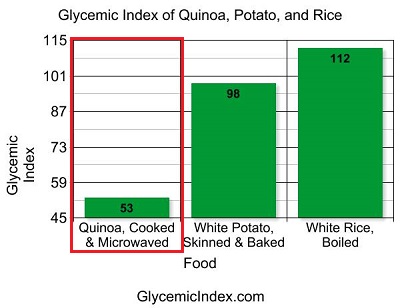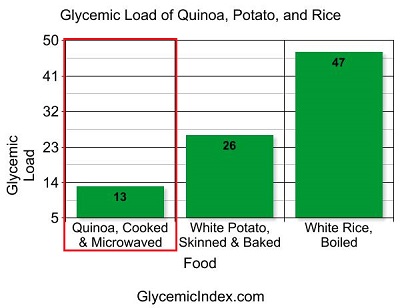Glycemic Index Quinoa
Glycemic Index Quinoa: What is the glycemic index of quinoa and why does it matter to you?
The glycemic index (GI) of quinoa is 53. And it’s glycemic load (GL) is 13.
But what do these numbers and terms mean in relation to your health?
To answer that question we need to explore the glycemic index of quinoa...
Glycemic Index Quinoa
Understanding the Glycemic Index
Every food has an amount of available or “net” carbohydrates.
As your body digests these carbohydrates, your blood sugar level rises. The glycemic index estimates the rate at which a food will raise your blood sugar.
The higher a food’s glycemic index, the faster it raises your blood sugar.
A food’s glycemic index falls on a scale of anywhere between 0 and 100 (theoretically). 100 represents the effect on your blood sugar that pure glucose or table sugar would have.
I say the upper limit of 100 is theoretical because some foods actually score higher. This just means they raise your blood sugar faster than pure glucose would.
We break the glycemic index (GI) down into three ranges: low, medium, and high...
- 55 and lower = low
- 56 - 69 = medium
- 70 and higher = high
How does quinoa score on this scale?
The Glycemic Index of Quinoa and Other Foods
Quinoa has a glycemic index of 53. So, it’s low on the GI scale. It should keep your blood sugar levels fairly steady and help you avoid those unwanted spikes.
For comparison’s sake let’s look at the GI of two other foods...
- A skinned baked potato has a GI of 98, which is almost as high as pure glucose.
- Boiled white rice has a GI of 112, which is even higher than table sugar!
A More Meaningful Measurement?
The way we calculate the glycemic index requires that the test subjects eat enough of a food so that they would consume about 50g of carbs.
For quinoa, this means the test subjects would need to eat about 250g of it. This is doable -- especially if you are a quinoa connoisseur like I am.
But if we needed to measure the GI of, say, watermelon -- we’d need to eat about 725g of it to get an accurate measurement! By the end you may be spitting more than just seeds!
So finding the GI of foods like watermelon is hard. And you’re never going to eat enough of it for the GI to be an accurate measurement of how fast it will raise your blood sugar level.
This is why we have a helpful measurement called the Glycemic Load...
Glycemic Index Quinoa: Glycemic Load
You calculate the glycemic load by multiplying the glycemic index of a food by the number of grams of available carbohydrate (or “net” carbohydrate) all divided by 100...
Glycemic Load = ( Glycemic Index x Net Carbs ) / 100
Quinoa has a glycemic load of 13 -- that is, ( 53 GI x 25 Net Carbs ) / 100.
The glycemic load (GL) breaks down into three ranges: low, medium, and high...
- 10 and lower = low
- 11 - 19 = medium
- 20 and higher = high
So quinoa -- with a GL of 13 -- has a medium glycemic load, though it’s on the lower side of medium.
Let’s see how potato and white rice compare...
- Skinned baked potato has a GL of 26, which is high -- double that of quinoa.
- Boiled white rice has a GL of 47, which is even higher.
But what’s the big deal with the glycemic index and glycemic load anyway? Why do these measurements matter to you?
Glycemic Index Quinoa: Glycemic Index and Diabetes
Studies have shown that prolonged periods of blood sugar spikes increase your risk of type-2 diabetes.
Foods with a low glycemic index -- like quinoa -- help prevent such spikes by converting to glucose slowly.
The result? A healthier you.
What's Next?
Our main topic on this page has been “glycemic index quinoa." But along the way we’ve talked about carbs. Check out our quinoa carbohydrates page for more helpful info.
I'd also recommend checking out a book called The Everything Low-Glycemic Index Cookbook. It has several recipes that include quinoa -- guaranteed to keep your blood sugar steady.
And finally, if you're interested in more details of quinoa nutrition, be our guest to read that delightful page.
Recommended Pages...
Recent Articles
-
Quinoa Recipes for Kids
Sep 13, 14 10:05 AM
Quinoa recipes for kids -- nutrition that kids will love!
-
Gluten-Free Quinoa Flat Bread
Aug 29, 14 07:17 AM
These are great hot off the griddle! Even try adding herbs like basil or garlic powder for extra flavor.The chia seeds add nutrition. But if you don't
-
Quinoa Bread Recipes
Aug 27, 14 07:11 AM
Add some nutritious quinoa to your daily bread with these unique quinoa bread recipes.



New! Comments
What do you think? Leave me a comment in the box below.